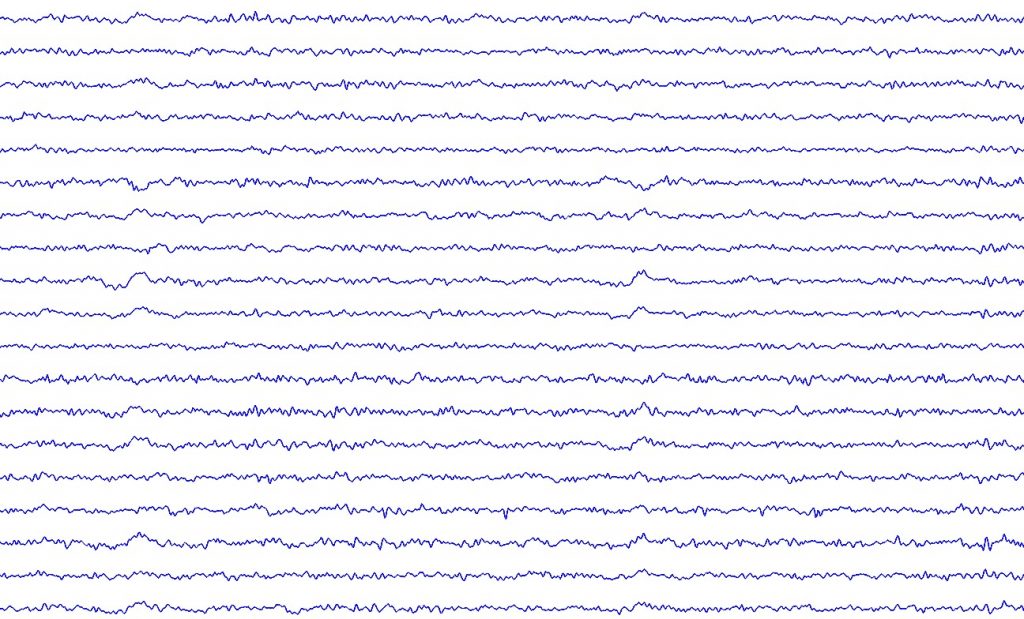
Hi everyone! I’m Santeri Lepistö, a master’s student in the neuroscience programme. I conducted my HiLIFE internship in Satu Palva’s research group, part of Palva Lab, at the University of Helsinki. During the trainee period I contributed to a research project that investigates how digital therapeutics can be utilized in the treatment of depression. Next, I will tell you about my thoughts regarding the internship experience!
Biological Brains and Digital Treatments
Since depression is a common and serious mental disorder, causing a significant amount of suffering, there is an evident need to gain new knowledge to understand it and new ways to treat it. During the internship I was involved in a research project that studies how a video game-based intervention can be utilized in the treatment of depression. In the study, the subjects go through an intensive period of video game playing, a training program, that aims to alter operations of the brain underlying cognitive functions. These neurocognitive alterations, in turn, can be linked to changes in the state of depression. In addition to video game-based intervention, the project exploits an extensive repertory of other methodological instruments, including multiple brain imaging methods, behavioral experiments and psychological questionnaires.
In my case, the internship made it possible to be absorbed in the daily practicalities of the project and participate in organizing and implementing the study – from recruitment to data acquisition. Before all, I focused on conducting magnetoencephalography measurements, behavioral tasks and clinical interviews for the subjects. Since there was diversity in my day-to-day duties, I had a chance to see how different methodological steps are connected in the project and what is the scientific value of some precise part of the study. So, experiencing the same project from many perspectives was informative! Clearly, understanding methodology is not just about putting cables into the right devices (which is indeed relevant), but becoming aware of the theoretical underpinnings how combinations of certain methodological choices serve the goals of study and capture valid information about the world. To take one example from my daily work, in the clinical interviewing – in which I examined subjects’ state of depression – it was essential to evaluate what kind of psychiatric symptoms are concordant with study’s research questions and how subjects’ different psychiatric and neurological conditions might influence to subsequent stages of the project, namely, brain imaging measurements, video game playing and, eventually, data analysis, results and theoretical interpretations. It was therefore necessary to know the specific scientific aims of the project and to keep in mind how one phase could affect another.

Brain’s Information Processing as a Window to Mental Health
Importantly, the internship gave me an opportunity to deepen my understanding of magnetoencephalography. The facilities of Meilahti Campus and the BioMag Laboratory at Helsinki University Hospital provided an adequate environment to collect magnetoencephalography data and, simultaneously, connect with inspiring people and learn from others. In the lab, it was not only rewarding to learn new but also to notice how the four-month training period made it possible to routinize oneself with many methodological procedures. Daily activities soon became habits. Also, efficient working in the lab is a must, since schedules are limited and each brain imaging session consisted of numerous steps, such as preparations of the lab settings, preparations of the participant, the actual brain imaging measurements and, additionally, use of psychological questionnaires and behavioral tasks.
What theoretically fascinated me in the utilization of magnetoencephalography was that the neuroimaging method illuminates brain’s architecture and activity from the perspective of information processing. As I contemplated in my previous blogpost, the human brain can be conceived as a complex information processing system that selects, modifies and transmits – or even creates – information. As an astonishing feat, this information processing, shaped by different biological and cultural forces (like natural selection and social conventions of our species cultural niche), orchestrates mental phenomena. Since magnetoencephalography gives an elegant access to brain’s information processing in the form of oscillatory activity, it is consequently possible to investigate what happens to brain’s information processing during depression.
When looking at the brain’s system-level information-processing in depression, several functional alterations, both increased and decreased connectivity, can be found within and between different neural networks [1, 2]. For instance, in a magnetoencephalography study of large-scale brain dynamics, it was found that central executive network hyper-intertwines with itself, whereas salience network hyper-integrates with other networks in depressed patients [2]. Moreover, the trainee months made me contemplate the heterogeneity of depression. Since varying biopsychological factors and symptoms have been linked to depression, it has been characterized as a heterogeneous clinical syndrome that might be caused by different pathological processes and, possibly, require various treatments. Also, it has been argued that different system-level functional alterations take place in different subtypes of depression. For example, in a fMRI study distinct subtypes were found based on differences in dysfunctional connectivity patterns of the fronto-striatal and limbic networks [3].

Thinking Science: Terms, Tools and Theories
Working in a scientific project provokes scientific thinking. In addition to learning about digital therapeutics in the treatment of mental disorders, oscillatory activity and subtyping of depression, the internship experience offered a great vantage point to think about scientific inquiry in general. The project, broad in its scale and important in its objective, provided a good impetus to contemplate how novel scientific knowledge comes into existence. To take a Simple View of Scientific Progress (a plain view on a complex process), I often found myself thinking scientific research through three interrelated domains: terms, tools and theories. Terms are the set of conditions where science takes place at a given period of time. Academic research has its surroundings, time and place. It emerges in a sociocultural matrix and is influenced by contemporary ideas, beliefs, values and resources – for instance, shared recognition of the importance of treating depression and other mental health problems. Tools, on the other hand, are the set of methodological ways that are harnessed to acquire scientific information – like magnetoencephalography and other brain imaging methods. Lastly, there are theories: systematically collected data can be transformed into sets of explanations about the world and models that imitate life – for example, more detailed and accurate understanding of depression. These perspectives, three Ts, can be considered tightly connected and guided by each other.
To sum up, I’m thankful for HiLIFE and Palva Lab for both educative and inspirational internship experience! Not only is science a process of seeking truth but it’s also a source of awe and amazement. It adds beauty to our lives by inviting to appreciate the many and diverse characteristics of reality, like simplicity and elegance, complexity and harmony, and hidden logic and patterns.
References
[1] Mulders, P. C., van Eijndhoven, P. F., Schene, A. H., Beckmann, C. F., & Tendolkar, I. (2015). Resting-state functional connectivity in major depressive disorder: a review. Neuroscience & Biobehavioral Reviews, 56, 330-344.
[2] Tian, S., Chattun, M. R., Zhang, S., Bi, K., Tang, H., Yan, R., … & Lu, Q. (2019). Dynamic community structure in major depressive disorder: A resting-state MEG study. Progress in Neuro-Psychopharmacology and Biological Psychiatry, 92, 39-47.
[3] Drysdale, A. T., Grosenick, L., Downar, J., Dunlop, K., Mansouri, F., Meng, Y., … & Liston, C. (2017). Resting-state connectivity biomarkers define neurophysiological subtypes of depression. Nature medicine, 23(1), 28-38.


